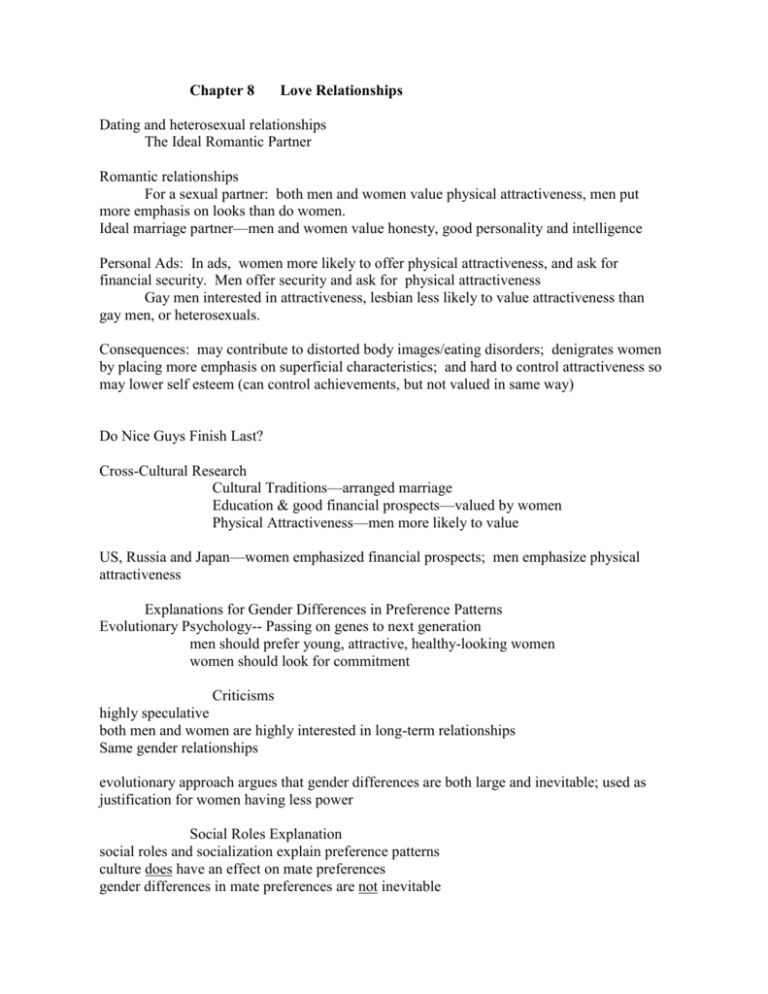
Chapter 8
Love Relationships
Dating and heterosexual relationships
The Ideal Romantic Partner
Romantic relationships
For a sexual partner: both men and women value physical attractiveness, men put
more emphasis on looks than do women.
Ideal marriage partner—men and women value honesty, good personality and intelligence
Personal Ads: In ads, women more likely to offer physical attractiveness, and ask for
financial security. Men offer security and ask for physical attractiveness
Gay men interested in attractiveness, lesbian less likely to value attractiveness than
gay men, or heterosexuals.
Consequences: may contribute to distorted body images/eating disorders; denigrates women
by placing more emphasis on superficial characteristics; and hard to control attractiveness so
may lower self esteem (can control achievements, but not valued in same way)
Do Nice Guys Finish Last?
Cross-Cultural Research
Cultural Traditions—arranged marriage
Education & good financial prospects—valued by women
Physical Attractiveness—men more likely to value
US, Russia and Japan—women emphasized financial prospects; men emphasize physical
attractiveness
Explanations for Gender Differences in Preference Patterns
Evolutionary Psychology-- Passing on genes to next generation
men should prefer young, attractive, healthy-looking women
women should look for commitment
Criticisms
highly speculative
both men and women are highly interested in long-term relationships
Same gender relationships
evolutionary approach argues that gender differences are both large and inevitable; used as
justification for women having less power
Social Roles Explanation
social roles and socialization explain preference patterns
culture does have an effect on mate preferences
gender differences in mate preferences are not inevitable
differences in mate preferences between cultures are much larger than the differences in mate
preferences between genders
Characteristics of Heterosexual Love Relationships
Gender Comparisons
friendship
liking, commitment, satisfaction
sadness, depression, hurt, loneliness
trust, caring, honesty, respect
strategies for maintaining a romantic relationship
Factors Related to Satisfaction with the Relationship
friendship —both men and women more satisfied with relationship if based
on friendship
skill at expressing emotions—when both able to express emotions
Breaking Up
women feel more joy and relief
men & women report similar negative emotions
picking up the signals
ambivalence
coping—blame, distractions
Marriage and Divorce
Average ages for first marriage—25-women; 27-men
½ North Americans married
Marriage rates and ethnicity
Marital Satisfaction
Satisfaction During Various Periods of Marriage
high regard from partner—happiest in marriage when felt valued
change over time—20-24 yrs marriage least satisfied, then starts to improve, children
grown
Satisfaction During Various Periods of Marriage
newlyweds
expectations and resentments
changes and satisfaction
Gender Comparisons in Marital Satisfaction
Devotion to marriage partner
Women report more extreme levels of emotion than men do
women more likely to report that marriage did not live up to ideal
women more sensitive to problems in relationship
both men and women happier if married than if not married
Characteristics of Happy Marriages—both feel emotional needs being met
1.
2.
3.
Emotional Stability
Communication skills and understanding,
More positive comments, rather than negative comments,
4.
5.
6.
7.
8.
9.
10.
Strong Conflict-resolution skills,
Trust in the other person,
Mutual support,
Belief that each spouse has genuine concern about other’s well-being
Flexibility,
Equal sharing of household tasks,
Equal sharing in decision making.
Responsibility and Power in Marriage
Salary and Power—money=power research: the more money husbands earn the more power
in decision making and less domestic tasks performed
Wives: when earn more than husband—not equal with financial matters
Three Patterns of Power Distribution
Traditional Marriage—husband more dominant, traditional gender roles
Modern Marriage—wife “junior partner”, say more equal, but man tends to
be more powerful wife’s work secondary
Egalitarian Marriage—share power equally, without traditional roles
companionship/sharing
Marriage and Women of Color
Divorce
Wives initiate divorce more often than husbands do
Reasons for divorce: physical or emotional abuse; infidelity; drug or alcohol abuse
Cohabitation and Divorce
Couples who live together before marriage are more likely to get divorced.
Cohabitation does not necessarily cause divorce.
Cohabitation: ½ of 1st marriages cohabitated.
Women may see more freedom from traditional roles in marriage. happier than than single people, not
as happy as married.
Divorce rates higher, may be due to: Selection effect: attitudes of ind. who cohabit are more
accepting of divorce and less commited to marriage than attitudes of non-cohabitors.
Psychological Effects of Divorce
Transitions and separations—make it painful
Stress, depression and anger
Positive feelings-may have been constrained in marriage
Financial Effects of Divorce
A woman's financial situation is usually worse following a divorce, especially if she has children
Many fathers fail to pay child support
Black mothers are even more likely than White mothers to face financial problems
Lesbians and Bisexual Women
Lesbian—psychologically, emotionally and sexually attracted to other women
Sexual Minority—anyone with same gender attraction
Heterosexism—bias against homosexuals
The Psychological Adjustment of Lesbians
homosexuality is not a mental disorder
the average lesbian is as well adjusted as the average heterosexual woman
in some studies, lesbians higher in self-esteem, self-sufficiency, ease of decision making
Likely to report a history with Hate crimes Depression, Anxiety
Lesbians who accept their lesbian identity have higher self-esteem than those who have not
accepted their lesbian identity
Community & Family
Characteristics of Lesbian Relationships
The Beginning of a Relationship
Equality in Lesbian Relationships
Equal decision making more important than equal salary
Housework
Satisfaction similar to heterosexual couples and gay male couples
Relationship Commitment
Psychological Intimacy
Breaking Up
Similar reasons;Same mix of emotions
Fewer factors preventing break up
Less support for relationship
Lack of support after break up
Lesbian Women of Color
Legal status of lesbian relationships
Single Women
Characteristics of Single Women—2000 census—about 23% women over 18 had
never married, 27% Canadian
more likely to work outside the home
choosing not to marry
similar to married women in psychological distress, life span
higher than marred women on independence
lower than married women on self-acceptance
Social relationships
Romantic status
People in 1990’s—less likely to use “old maid, spinster”
1970—10% 25-29 yr olds unmarried
2000—39%
Attitudes Toward Single Womena; Singleism
1980’s research—single women perceived to be less sociable, less attractive and less
reliable
Single women: substantial %age of adult women, yet little research conducted on this group.
Many single women highly educated and career-oriented—singlehood allows more flexible
work hours and geographic mobility
Chose not to marry—did not find ideal partner
Similarities in these areas to married women: in scores on measures of psychological distress;
life span; live longer than divorced women. Single women score higher on measures of
independence, lower on self-acceptance tests.
Poll--sample of New York heterosexual women, ages 21-40: 34% happily single and dating;
27% happily single and not dating.
30% looking for romantic relationship, 5% described self as “panicking”.
trend in number of women remaining single—“increasing recognition that singlehood can be
legitimate, healthy and happy alternative to marriage”
Advantages and Disadvantages of Being Single
Freedom—do what they want
Privacy—be by themselves
Free to be themselves
Self-knowledge
Loneliness
Cultural bias
Create own Social networks








